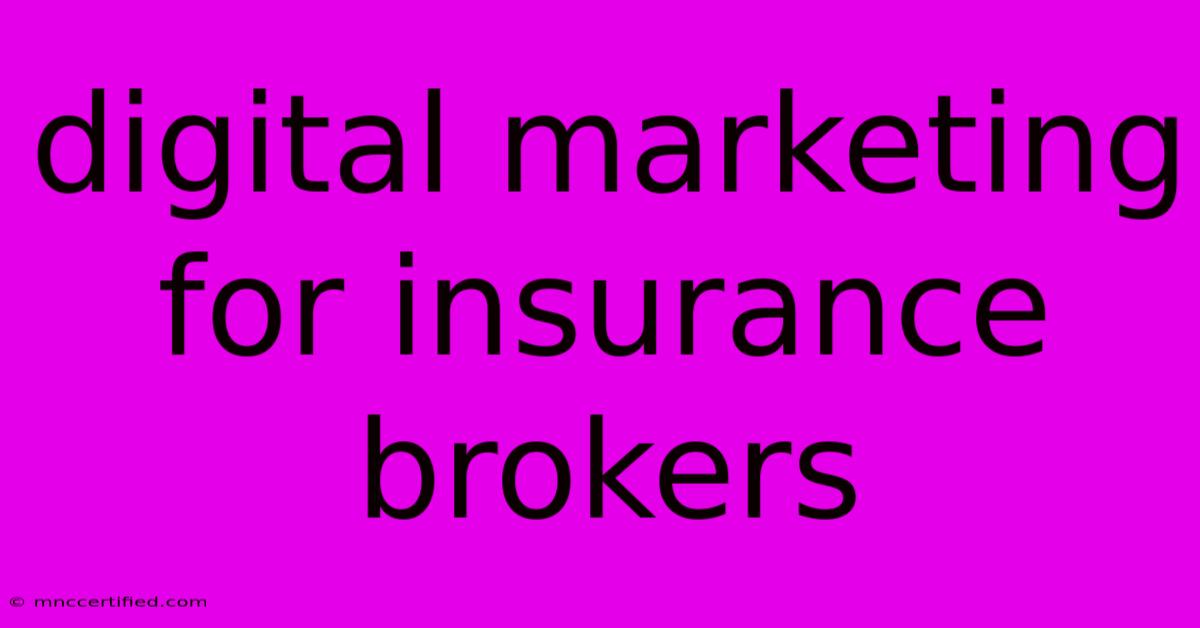Digital Marketing For Insurance Brokers

Table of Contents
Digital Marketing Strategies for Insurance Brokers: A Comprehensive Guide to Growth
In today's competitive landscape, digital marketing is no longer optional for insurance brokers - it's a necessity. With consumers increasingly relying on online resources for information and research, it's crucial to have a robust digital presence to attract and retain clients. This comprehensive guide will delve into the most effective digital marketing strategies for insurance brokers, helping you build a strong brand, reach your target audience, and ultimately drive growth.
1. Establish a Strong Online Presence: Your Digital Foundation
A. Website Optimization:
- User-friendly website: Your website is your digital storefront. Ensure it's user-friendly, mobile-responsive, and visually appealing. A clear navigation structure, compelling content, and easy-to-find contact information are essential.
- SEO optimization: Optimize your website for relevant keywords to improve search engine ranking. Conduct keyword research to identify terms your target audience uses when searching for insurance services.
- Local SEO: Highlight your location and target local customers. Use Google My Business to manage your online presence, ensuring your business information is accurate and up-to-date.
B. Social Media Marketing:
- Choose the right platforms: Focus your efforts on platforms where your target audience spends their time. LinkedIn, Facebook, and Twitter are popular choices for insurance brokers.
- Share valuable content: Provide insights, tips, and advice on insurance-related topics. Use infographics, videos, and engaging articles to capture attention.
- Engage with your audience: Respond to comments, answer questions, and participate in conversations to build relationships.
2. Content Marketing: Educate and Engage Your Audience
A. Blog Content:
- Informative and engaging posts: Create content that addresses common insurance questions, explains policy types, or provides tips for protecting yourself.
- Keywords and SEO: Use relevant keywords throughout your blog posts to improve search engine visibility.
- Promote your content: Share your blog posts on social media and email them to your subscribers.
B. Video Marketing:
- Create informative videos: Explain complex insurance concepts in a clear and concise way.
- Use testimonials: Showcase positive experiences from existing clients to build trust and credibility.
- Promote your videos: Share your videos on social media, embed them on your website, and upload them to YouTube.
3. Leverage Email Marketing to Nurture Relationships
A. Targeted Email Campaigns:
- Build your email list: Offer valuable content in exchange for email sign-ups.
- Segment your audience: Create different email lists based on demographics, interests, and policy types.
- Personalized content: Tailor your emails to the specific needs and interests of your subscribers.
B. Email Automation:
- Welcome sequences: Welcome new subscribers with a series of automated emails that introduce your business and its services.
- Follow-up campaigns: Send automated emails to nurture leads and encourage them to take the next step.
- Renewal reminders: Remind clients about upcoming policy renewals to encourage retention.
4. Pay-Per-Click (PPC) Advertising: Reaching Your Target Audience Instantly
A. Google Ads:
- Target specific keywords: Use Google Ads to target relevant search terms that your potential clients are using.
- Geotargeting: Reach customers within a specific geographic area.
- Track your results: Monitor your ad performance and adjust your campaigns accordingly.
B. Social Media Advertising:
- Targeted ad campaigns: Use Facebook, Instagram, and other platforms to target specific demographics and interests.
- Retargeting: Reach users who have previously visited your website or interacted with your social media pages.
- Analyze your results: Track your campaign performance and optimize your ad spending.
5. Analytics and Tracking: Measure Your Success
A. Google Analytics:
- Website traffic: Monitor website traffic, page views, and bounce rates.
- Conversion tracking: Track the number of leads generated and conversions from your website.
- User behavior: Analyze how visitors navigate your website to identify areas for improvement.
B. Social Media Analytics:
- Engagement metrics: Track likes, shares, comments, and other engagement metrics.
- Reach and impressions: Measure the number of people who saw your social media posts.
- Audience demographics: Understand the age, gender, location, and interests of your audience.
6. The Power of Partnering: Building a Network of Support
A. Collaborate with other businesses: Partner with complementary businesses, such as mortgage brokers, real estate agents, or financial advisors, to cross-promote your services.
B. Join industry associations: Network with other insurance professionals to share best practices, build relationships, and generate referrals.
C. Engage with influencers: Reach a wider audience by partnering with industry influencers who can promote your services to their followers.
By embracing these digital marketing strategies, insurance brokers can effectively reach their target audience, build strong relationships, and drive sustainable growth in the competitive insurance market. Remember, it's an ongoing process that requires consistent effort and adaptation. Stay informed about the latest trends and technologies to ensure your digital marketing efforts remain effective and relevant.

Thank you for visiting our website wich cover about Digital Marketing For Insurance Brokers. We hope the information provided has been useful to you. Feel free to contact us if you have any questions or need further assistance. See you next time and dont miss to bookmark.
Featured Posts
-
Zach Bryans This Worlds A Giant A Thank You
Nov 08, 2024
-
Internet In North Korea Initial User Behavior
Nov 08, 2024
-
Uk Interest Rates Cut To 4 75 Fewer Drops Ahead
Nov 08, 2024
-
German Government Collapse Why Now
Nov 08, 2024
-
Bear River Mutual Insurance Murray Utah
Nov 08, 2024